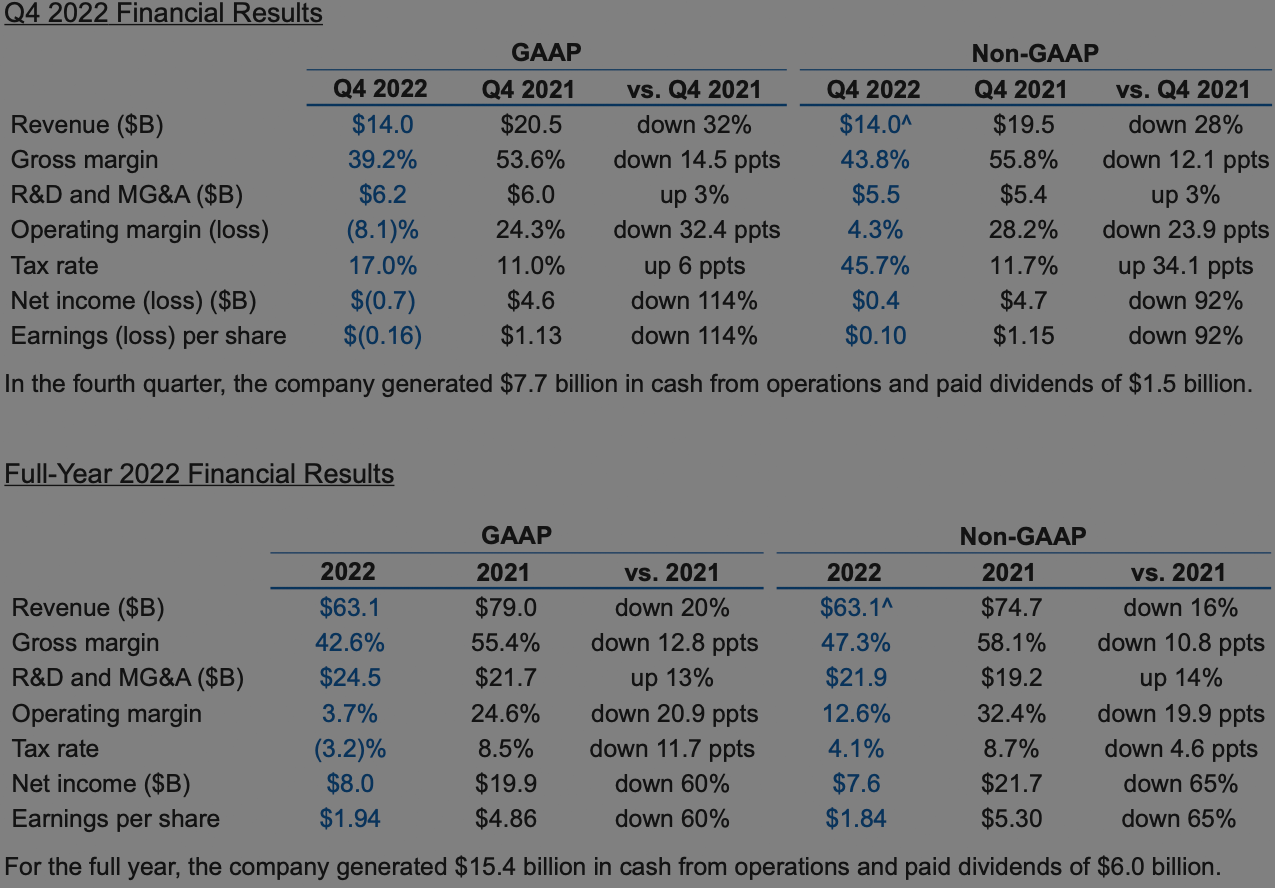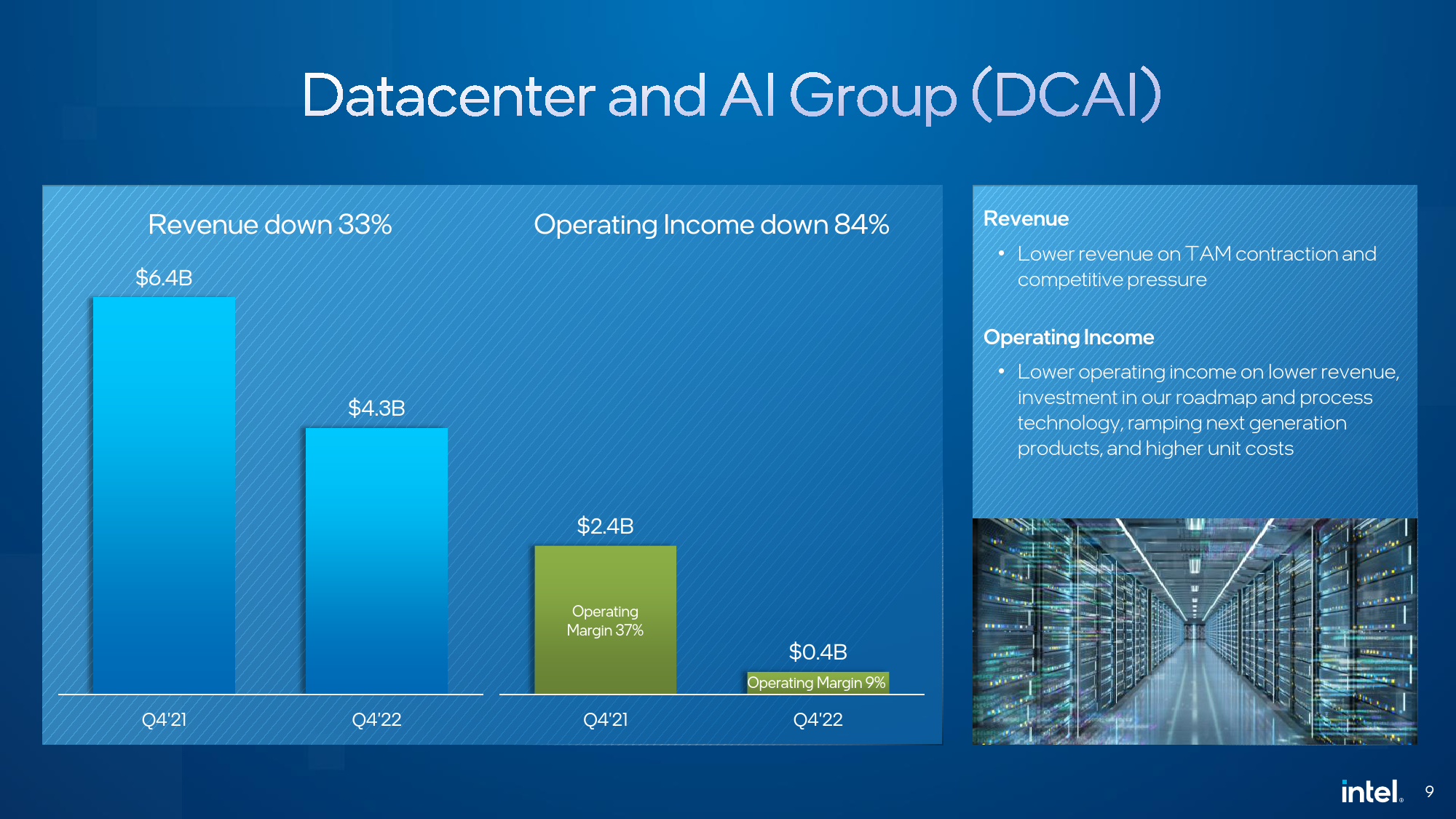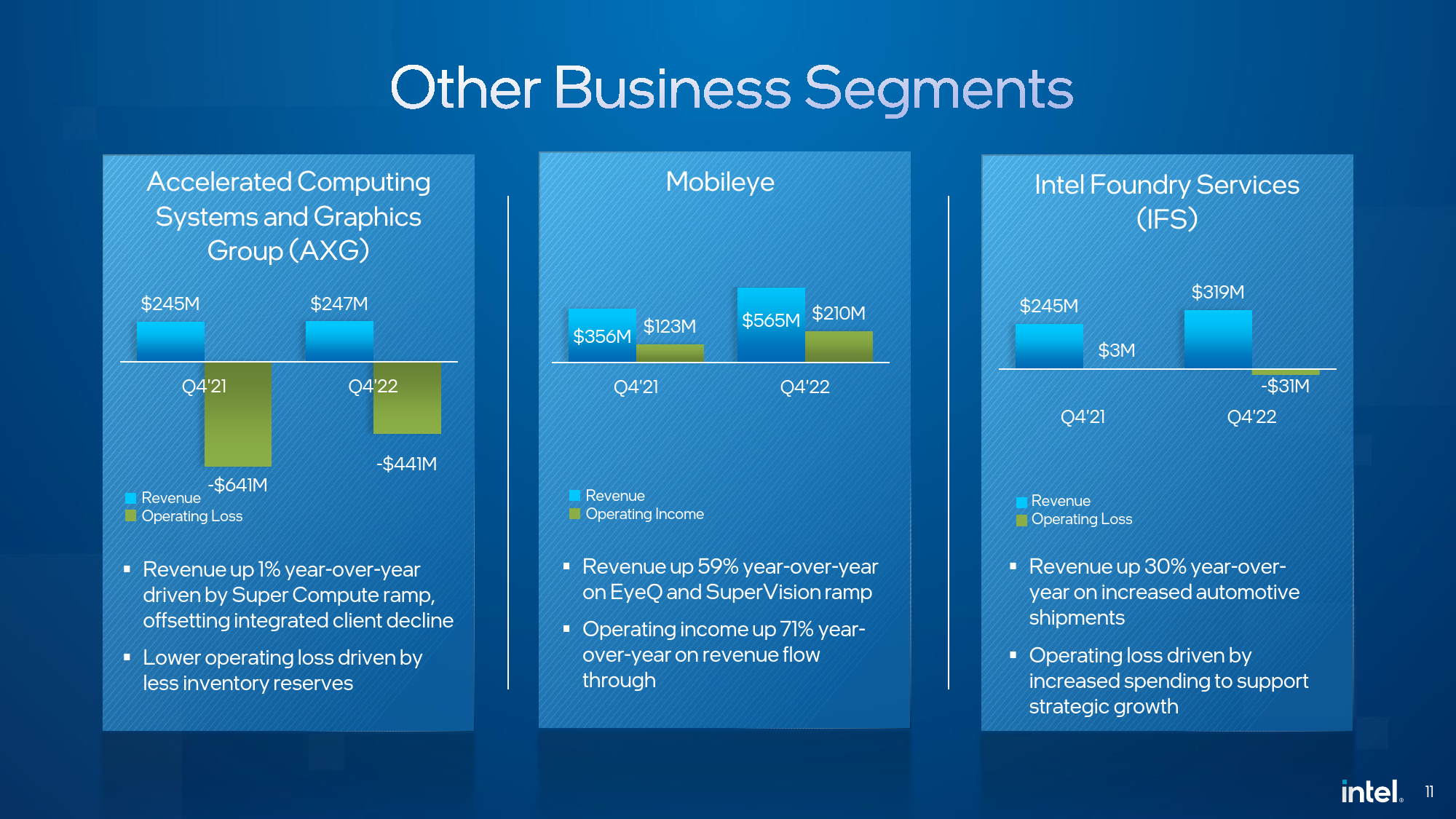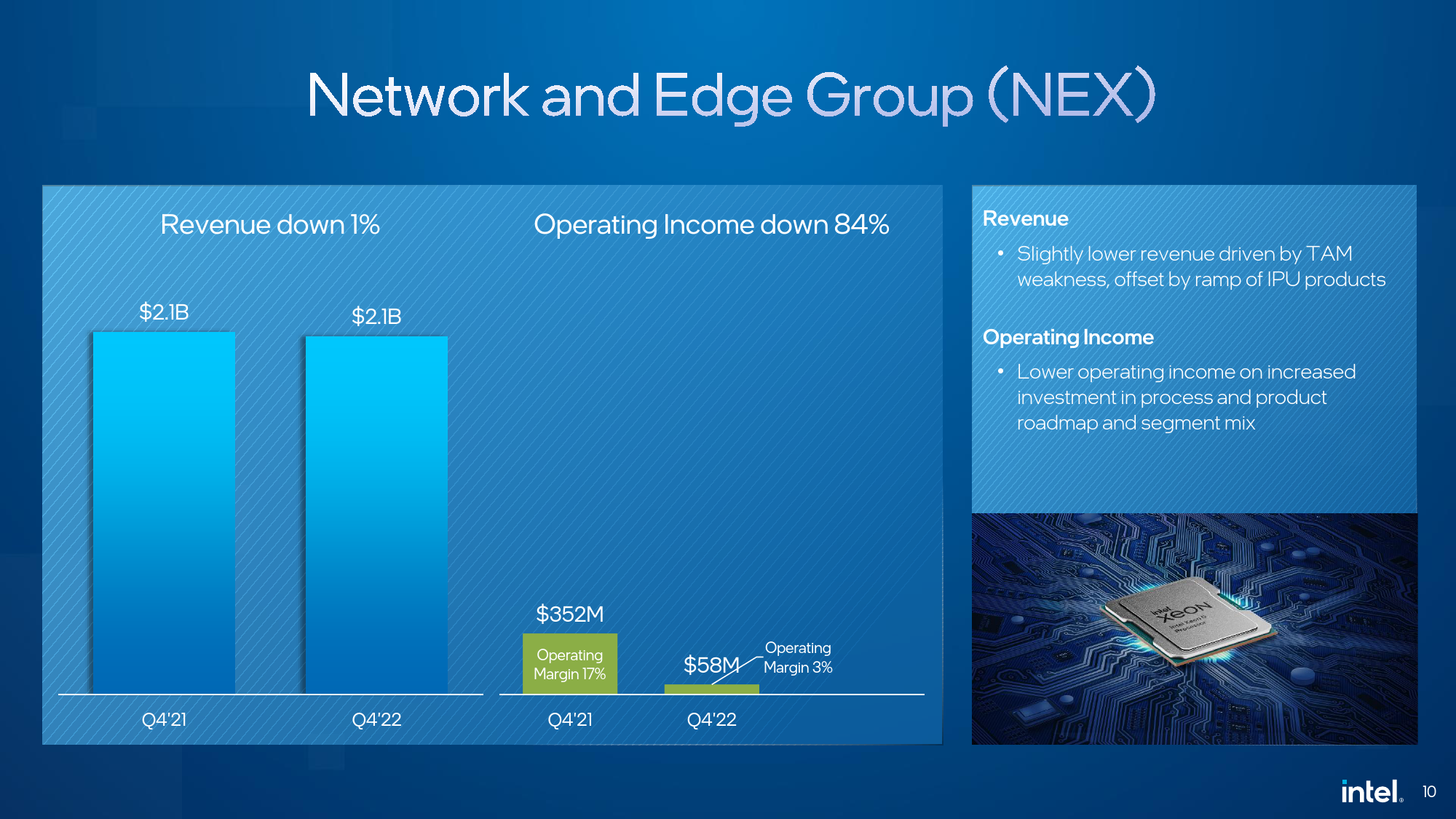Intel Posts Largest Loss in Years as PC and Server Nosedives
Intel remains committed to long term goals despite disaster Q4 2024.
Intel on Thursday posted rather grievous financial results as the company's revenue for the quarter dropped both sequentially and year-over-year, and the company lost $700 million as its margins collapsed to a multi-year minimum. While the company remained profitable in 2022, it said its earnings would drop further this quarter as its customers will aggressively cut their inventory. Intel expects its sales to decrease even further next quarter.
Revenue Down, Margins Drop
Intel's Q4 FY2022 revenue dropped to $14 billion, which is 32% lower than in the same quarter a year ago. The company's gross margin decreased to 39.2% from 53.6% in the fourth quarter of fiscal 2021.
The 39.2% gross margin is the lowest gross margin that Intel posted in years, if not decades. Also, the company lost $664 million in the quarter, which is almost the company's largest quarterly loss ever. The company lost $687 back in Q4 FY2017 because of a declining PC market, so this time the hit was a bit lower.
The results for the whole year do not look good, either: Intel's 2022 revenue totaled 63.1 billion, down 20% YoY, and gross margin decreased to 42.6%, whereas net income collapsed to $8 billion, or down by 60% YoY.
The company admits the results are nothing to brag about, so instead, it stresses that it is working to achieve its strategic goals despite the huge challenges. The company also says it had to adjust its operating costs, review its roadmap, and even reduce headcount.
"Despite the economic and market headwinds, we continued to make good progress on our strategic transformation in Q4, including advancing our product roadmap and improving our operational structure and processes to drive efficiencies while delivering at the low-end of our guided range," said Pat Gelsinger, chief executive of Intel. "In 2023, we will continue to navigate the short-term challenges while striving to meet our long-term commitments, including delivering leadership products anchored on open and secure platforms, powered by at-scale manufacturing and supercharged by our incredible team."
Client PC and Datacenter Business Units Barely Profitable

Intel's Client Computing Group is the company's bread and butter, but last quarter it only earned $6.6 billion, down from $10.3 billion in the same period a year before. Nevertheless, with an operating margin of 11%, the unit brought Intel some $700 million in non-GAAP profit.
Intel blames lower revenue on weak PC demand in consumer and education and PC OEM inventory reductions. The company did not mention whether it had to sell certain client PC products at huge discounts in the quarter, though given that sales of client CPUs and chipsets are down 36% year-over-year, it looks like the decline had something to do with both average selling prices and volumes. Also, Intel noted that products made on its Intel 7 fabrication process (aka 10nm Enhanced SuperFin) are relatively costly to produce, affecting its profitability.
As for the Datacenter and AI group, its revenue dropped to $4.3 billion from $6.4 billion a year before, whereas its profitability collapsed to $0.4 billion from $2.4 billion in the fourth quarter of the previous year.
Intel says that the earnings and profitability of its DCAI business contracted because of soft demand for servers and competitive pressure from AMD. Considering that Intel had to delay its latest Xeon Scalable 'Sapphire Rapids' CPUs by well over a year, it is unsurprising that AMD is eating Intel's launch. It is also noteworthy that Intel's data center business is nearly two times less profitable than its client PC business that sells products with lower margins.
Get Tom's Hardware's best news and in-depth reviews, straight to your inbox.
But even though Intel's CCG and DCAI groups were at least profitable, Intel's Accelerated Computing Systems and Graphics Group (AXG) lost $441 million amid $245 million in revenue, up 1% year-over-year. Last year Intel finally launched its discrete Arc graphics processors for desktops and laptops, which apparently did not help the group's earnings much. So even though it's good to see that AXG reduced its losses, it is still unprofitable.
Interestingly, Intel's Network and Edge Group (NEX) maintained its $2.1 billion revenue (flat YoY), but its profitability shrunk from $352 million in Q4 FY2021 to $58 million in Q4 FY2022.
As for the company's Intel Foundry Services, its revenue increased by 30% to $319 million compared to the same period a year ago. However, according to Intel, it still generated a $31 million operating loss as it needed funds to support strategic growth.
Intel's MobileEye is another business demonstrating steady YoY growth despite economic turmoil. It booked $565 million in revenue due to the EyeQ and SuperVision ramp, up 59% from the same period a year before. Furthermore, it also generated $210 million in net profits, up from $123 million a year before.
No Full Year Outlook
Given the uncertainties for its key CCG and DCAI business units, Intel didn't provide any revenue outlook for the whole year. Meanwhile, the company expects its Q1 FY2023 revenue to be between $10.5 billion and $11.5 billion, significantly below earnings in Q4 2022. Furthermore, the company predicts its gross margin will fall to 34.1%.
Such expectations can be explained by the aggressive inventory corrections by PC OEMs and server makers that Intel predicts will happen in Q1 2023. Meanwhile, it also means that Intel does not expect an immediate impact of recent product launches (mobile Raptor Lake, Sapphire Rapids, Ponte Vecchio) on its business results.

Anton Shilov is a contributing writer at Tom’s Hardware. Over the past couple of decades, he has covered everything from CPUs and GPUs to supercomputers and from modern process technologies and latest fab tools to high-tech industry trends.
-
InvalidError It shouldn't surprise anyone that the ~100M extra units surge sold to corporations and people for out-of-cycle COVID upgrades would come at the expense of depressed sales for the following 3-10 years until everyone's periodic refresh cycles resume. Inflation from the COVID cash injection bubble and economic uncertainty on top don't help either.Reply -
watzupken All the tech companies that fattened themselves up over the last 3 years are in for lean times. I have doubts over the profitability of Intel in the foreseeable future. Competition is fierce and they don't seem to have any edge over their competitors like they used to. Also the decision to triple down creating or expanding fans with all their fab competitors doing the same is going to drag them down in my opinion. I feel a lot of capacity will be created, though I am not sure red hot chip demand can sustain.Reply -
prtskg Reply
Makes one wonder what kind of magic does that leather jacket user does at Nvidia to get greater than 60% gross margin again and again.watzupken said:All the tech companies that fattened themselves up over the last 3 years are in for lean times. I have doubts over the profitability of Intel in the foreseeable future. Competition is fierce and they don't seem to have any edge over their competitors like they used to. Also the decision to triple down creating or expanding fans with all their fab competitors doing the same is going to drag them down in my opinion. I feel a lot of capacity will be created, though I am not sure red hot chip demand can sustain. -
TechieTwo Replyprtskg said:Makes one wonder what kind of magic does that leather jacket user does at Nvidia to get greater than 60% gross margin again and again.
He charges $1500 for a video card and some people are willing to pay those prices. -
PlaneInTheSky The reason I am not "upgrading" my PC is two-fold.Reply
1) The price of GPU and motherboards is insane. I am not about to pay $600+ for a midrange GPU or $300+ for a midrange motherboard. These prices need to be halved and the power usage of GPU needs to come down drastically too.
2) "AAA" games have sucked for a while now. Death Stranding. Sonic Frontiers. Forspoken, these games just blow. The most fun I am having is with smaller games that run on a potato. -
TechieTwo Intel was somewhat isolated from economic downturns in the past when they had a large installed base and controlled the CPU playing field. Since AMD's EPYC processors have taken significant market share from Intel, Intel has had to lower prices and use a lot of "marketing" money to create sales. Even Dell which has always been an Intel house has had to switch to AMD's EPYC systems to meet enterprise demand.Reply
Intel also has a habit of buying smaller companies with new tech and then managing to run them into the ground and shuttering them after a few years. That can eat up a lot of capitol. -
suryasans People with higher disposable income think that a glowing big brick in their 2 grand diy PC is cool.Reply -
Fates_Demise Replyprtskg said:Makes one wonder what kind of magic does that leather jacket user does at Nvidia to get greater than 60% gross margin again and again.
Nvidia is also the world leader in AI computation cards by a large margin. A very large portion of sales are from workstations. -
Fates_Demise ReplyPlaneInTheSky said:The reason I am not "upgrading" my PC is two-fold.
1) The price of GPU and motherboards is insane. I am not about to pay $600+ for a midrange GPU or $300+ for a midrange motherboard. These prices need to be halved and the power usage of GPU needs to come down drastically too.
2) "AAA" games have sucked for a while now. Death Stranding. Sonic Frontiers. Forspoken, these games just blow. The most fun I am having is with smaller games that run on a potato.
People don't really care about the power consumption (yet), nobody goes home whining about oh man... my computer is sucking down a extra 100 watts while I'm gaming vs my last computer.
What they do care about is the extra performance that allows.



